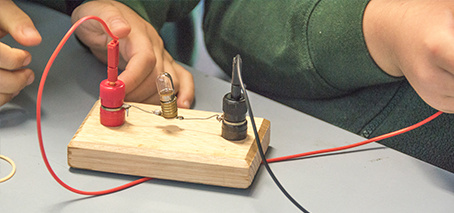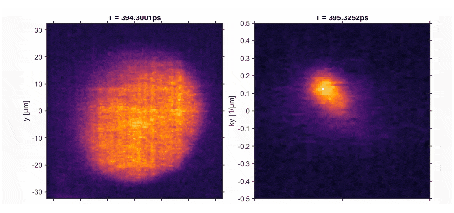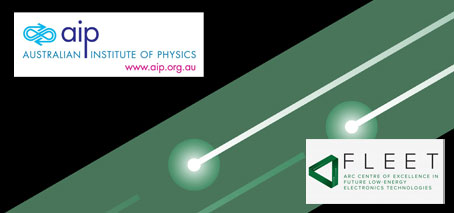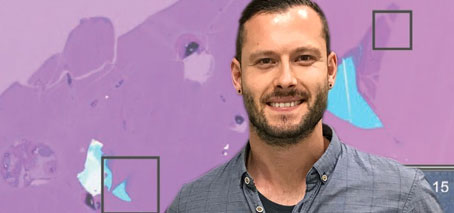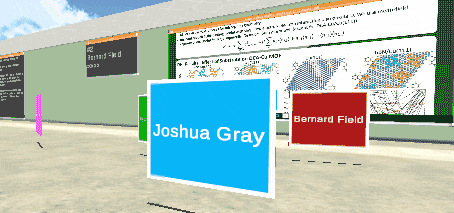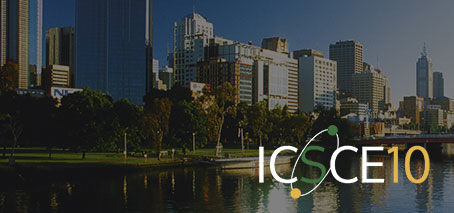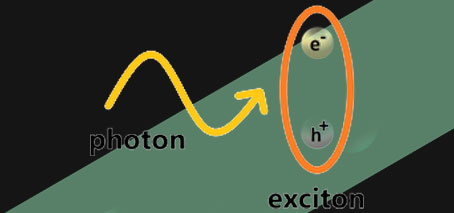FLEET is dialling in to the online APS March Meeting from afar this year! Here’s a list of talks given by FLEET members and affiliates throughout the week to check out (if you have registered for the conference, catch-up links are provided on each page). Monday 15 March Ali Yazdani (Princeton University, FLEET Advisory Committee) Correlation and topology in magic …
Engaging senior school students at JMSS in 2020
In 2020, FLEET continued the Year 10 ‘Future electronics’ course launched the year before in partnership with John Monash Science School (JMSS), Victoria. As well as covering the history of semiconductors, Moore’s Law and computing, the course introduces quantum physics at an intuitive level (with minimal maths) and expands on this fundamental understanding to explain complex, useful quantum states such …
‘Target identified’: teaching a machine how to identify imperfections in 2D materials
Applying machine learning to automated characterisation of atomically-thin materials Just as James Cameron’s Terminator-800 was able to discriminate between “clothes, boots, and a motorcycle”, machine-learning could identify different areas of interest on 2D materials. The simple, automated optical identification of fundamentally different physical areas on these materials (eg, areas displaying doping, strain, and electronic disorder) could significantly accelerate the science …
Sloshing quantum fluids of light and matter to probe superfluidity
The ‘sloshing’ of a quantum fluid comprised of light and matter reveals superfluid properties. An Australian-led team of physicists have successfully created sloshing quantum liquids in a ‘bucket’ formed by containment lasers. “These quantum fluids are expected to be as wavy as the oceans, but catching clear pictures of the waves is an experimental challenge,” says lead author Dr Eliezer …
Spotlighting ARC physics in 2020
FLEET pushed out the boundary of online talks, collaborating with the Australian Institute of Physics (AIP) to co-host a series of monthly public seminars highlighting Australian physics research. The new series throws the spotlight on a different Australian Research Council Centre of Excellence each month, with AIP members and others in the physics community joining over Zoom to hear about …
US-Australia Transpacific Colloquium – Dmitri Basov: Programmable Quantum Materials
Experimentally realizing quantum phases of matter and controlling their properties is a central goal of the physical sciences. Novel quantum phases with controllable properties are essential for new electronic, photonic, and energy management technologies[i]. Quantum materials offer particularly appealing opportunities for the implementation of on-demand quantum phases. This class of materials host interacting many-body electronic systems featuring an intricate interplay …
Encasing fragile 2D semiconductors in ultrathin glass: A route towards compact ultra-low energy electronics
Encasing fragile 2D materials in ultrathin gallium-oxide glass could allow integration into functional low-energy devices Two-dimensional (2D) semiconductors have emerged during the past decade as extremely promising for future electronic and optoelectronic devices. However, to unlock the significant potential of these fragile materials, we must first find a way to protect them in functional devices, while maintaining their key electronic …
Publications
Pushing virtual meeting technology: FLEET’s online annual workshop 2020
With strict Covid-19 restrictions across much of FLEET’s Australian nodes, and eliminating international visitors, the decision was made to hold the Centre’s 2020 annual workshop entirely online. By this time, Centre decision-makers were well aware of ‘Zoom fatigue’. People spending many hours on Zoom each week were finding interacting only via computer screen to be dis-engaging, and surprisingly exhausting. In …
Putting FLEET science on the map
Topological transistors added to IEEE International Roadmap for Devices and Systems The remarkable advances in semiconductor technology (guided by the so-called ‘Moore’s Law’ over some six or seven decades) don’t just happen. They are steered through an international, pre-competitive industry roadmap. The IEEE International Roadmap for Devices and Systems ‘IRDS’ is the latest semiconductor roadmap, guiding development of more conventional …
Hosting FLEET research seminars in 2020
FLEET turbo-charged our existing Centre-wide seminar series in 2020, with 10 research seminars – a significant increase from only four seminars in 2019. Very aware of the importance of Centre cohesion without inter-state travel and with many universities in lockdown, FLEET threw extra resources into monthly Zoom seminars, often overlapping with expanded ‘journal club’ meetings involving multiple interstate visitors. Two …
Hosting scientific meetings in 2020 (ICSCE10)
In January 2020 FLEET brought the 10th International Conference on Spontaneous Coherence in Excitonic Systems (ICSCE10) to Australia for the first time. Continuing this 15-year tradition from the global scientific community interested in various quantum phenomena, ICSCE10 was hosted at the Arts Centre Melbourne amidst smoke storms resulting from one of the worst bushfire seasons in Australia’s history. ICSCE10 brought …
Polariton interactions: Light matters
Enhanced interactions through strong light-matter coupling Why do two-dimensional exciton-polaritons interact? The intriguing quasiparticle the exciton-polariton is part light (photon), and part matter (exciton). Their excitonic (matter) part confers them the ability to interact with other particles —a property lacking to bare photons. In theory, when confined to only two dimensions, very slow (ie, very cold) excitons should cease any …
Opportunities for Members
Optoelectronics based on Transition Metal Dichalcogenide/2D Perovskite Heterostructures
About the presenter Abin Varghese is a PhD student working with CI Nikhil Medhekar.
Polariton pillar cavity: polarization, interactions, correlations
About the presenter Dr Olivier Bleu is a Postdoctoral Research Fellow working with A/Prof Meera Parishand Dr Jesper Levinsen at Monash University within FLEET’s Research themes 2: Exciton superfluids. His research interests include Berry curvature and related effects, topological photonics, Bose-Einstein condensates and exciton-polariton physics.
Congratulations Matthias Wurdack
Congratulations to ANU’s Matthias Wurdack on winning the AIP NSW Postgraduate Award this month for his presentation “Towards future low-energy transistor technologies with exciton-polariton superfluids in atomically thin semiconductors.” Matthias received the 2020 AIP Crystal Postgraduate figurine, and a $500 award from the Australian Institute of Physics. The NSW Branch of the Australian Institute of Physics in conjunction with the …
Towards contacting monolayer TMDC through touch-printed Ga2O3 tunnel barriers
About the presenter One of the three inaugural Women in FLEET fellows, Dr Semonti Bhattacharyya is contributing to FLEET Research theme 1, topological materials, Research theme 2, exciton superfluids and Enabling technology theme A, atomically-thin materials, working with Prof Michael Fuhrer. As an experimental condensed matter physicist, she has worked extensively on electrical transport properties of topological materials and …
Intrinsic and extrinsic effects on Dirac fermions in graphene covered by Ga2O3
About the presenter Matthew Gebert is a PhD student in Prof Michael Fuhrer’s group at Monash University, investigating the interface between the 2D surface state of a 3D topological insulator (TI) with a thin, insulating ferromagnetic material. The aims of the project are to understand the effects of time-reversal symmetry breaking on the topological insulator and to investigate the …
Topological shift current in two-dimensional transition metal dichalcogenides
Monolayer transition metal dichalcogenides (TMDCs) with broken inversion symmetry have shown unique optical response properties. We calculate the topological phase shift of MoS2 as a prototype of TMDs systems involving the Berry connection in the presence of inter-valley scattering processes. Our results are based on two alternative approaches; quantum kinetic theory where we calculate the non-equilibrium distribution function of each …
Transport measurements in amorphous Bi2Te3
Amorphous materials have recently been theoretically predicted to have topologically protected states [1,2]. These results are contrary to the well understood mechanisms that topological states originate from a material’s electronic band structure which requires certain symmetries to be present. Additionally, amorphous materials often allow for the synthesis of non-equilibrium compositions or doping concentrations that are not accessible in crystalline systems. …
Coherent dynamics and band structure control in monolayer WS2
Using ultrafast laser pulses we demonstrate adiabatic control of the bandstructure of monolayer WS2 through Floquet engineering. In other words the periodic electric field of the laser pulse dresses the Bloch bands of the semiconductors. Interactions between the dressed bands then cause energy shifts, avoided crossings and the potential to induce a topological phase transition. The use of coherent spectroscopy …
Using Light to Probe and Manipulate Topologically Non-Trivial States
In this talk I will present the case for using high-electric field, ultrashort femtosecond pulses of light to controllably switch the behaviour of topologically interesting systems such as the Dirac semimetal, graphene. I will also outline our research efforts in this space and why quasi-single cycle terahertz probe pulses provide a unique window into the dynamics and optical properties …
Double Moire superlattices in hBN encapsulated graphene
Isolation of monolayer and few-layer graphene and other two-dimensional materials provides an opportunity to fabricate new types of heterostructures by stacking them layer by layer in a designed sequence [1]. Previous studies show that putting a graphene on a hexagonal boron nitride (hBN) substrate could form a Moiré pattern which generates a periodic potential and creates new Dirac points in …
Room-temperature polaritonics in FLEET
Exciton-polaritons (polaritons herein) are bosonic quasiparticles with unique physical properties arising from strong coupling between excitons and confined photons. Since their first demonstration, exciton-polaritons became a convenient platform for studies of collective quantum effects such as Bose-Einstein condensation and superfluidity. To date, the most striking effects were cleanly demonstrated in GaAs- based microcavities due to the very low defect densities …
Polariton-Polariton Interaction: a four-body calculation
About the presenter Dr Guangyao Li is a postdoc researcher working with A/Prof Meera Parish and Dr Jesper Levinsen at Monash University within FLEET’s Research themes 2 (exciton superfluids) and 3 (light-transformed materials). His research interests include dynamics of polariton condensates, chiral states at exceptional points, topological excitations in open-dissipative superfluid, and the spin-orbit interaction of light.
Toward high-performance tungsten diselenide field-effect transistors
About the presenter Yi-Hsun Chen is an experimental physicist working with Prof Michael Fuhrer and Dr Chen Shao-Yu at Monash University, where he researches Bose-Einstein condensates using devices constructed using 2D materials, seeking exciton superfluids in 2D material quantum wells. His research falls under FLEET research theme 2 exciton superfluids. For his PhD project, he is using 2D materials to create …
Topological spin-plasma waves at the interface of a topological insulator and a magnet
About the presenter Dr Dmitry Efimkin is a Scientific Associate Investigator at Monash University specialising in novel materials such as Dirac materials, graphene and topological insulators, and optical phenomena in solids. Within FLEET, Dmitry works with Michael Fuhrer, Meera Parish, and Nkhil Medhekar in Research theme 2: exciton superfluids and Enabling technology A: atomically-thin materials, studying optical and collective phenomena …
Coherent Dynamics in WS2 monolayers
Engineering low-loss phonon polaritons in anisotropic 2D materials
About the presenter Qingdong Ou is a research fellow working with Prof Michael Fuhrer at Monash University to study nano-device fabrication based on 2D materials, within FLEET’s Enabling technology B. Qingdong is seeking to minimize energy losses in light-matter interactions, aiming to realise ultra-low energy consumption in 2D-semiconductor-based optoelectronics. He also studies carrier behaviour via microscale photoluminescence and photocurrent mapping, and …


